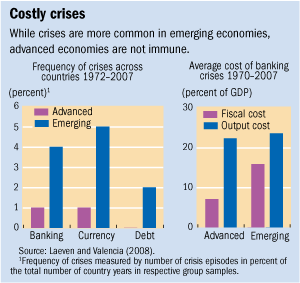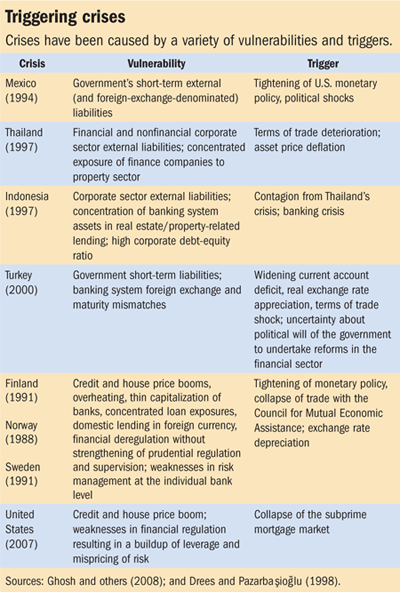Anticipating the Next Crisis
Finance & Development, September 2009, Volume 46, Number 3
Atish R. Ghosh, Jonathan D. Ostry, and Natalia Tamirisa
What can early warning systems be expected to deliver?
“Often public officials have two unfortunate incentives: to give undue attention to worst-case scenarios and to pay no attention to them at all. Sometimes their electoral prospects, or their overall popularity, depend on one or the other.”
Cass R. Sunstein, Worst-Case Scenarios
 THE current global financial turmoil has rekindled the interest of both policymakers and the general public—after nearly a decade of calm since the emerging market crises of the 1990s—in early warning systems (EWS) to anticipate future financial crises. But what alarms can such systems realistically sound? How would they work? And would they be effective?
THE current global financial turmoil has rekindled the interest of both policymakers and the general public—after nearly a decade of calm since the emerging market crises of the 1990s—in early warning systems (EWS) to anticipate future financial crises. But what alarms can such systems realistically sound? How would they work? And would they be effective?
Experience with past crises suggests that, for both advanced and emerging economies, crises are very costly (see chart). Whereas each differs in its details, nearly all reflect a confluence of some underlying economic vulnerability and a specific crisis trigger. The underlying vulnerability is often a credit or asset price bubble, a balance sheet mismatch (excessive borrowing in foreign currency, at too-short maturities, or with inadequate capitalization), whereas the crisis trigger can be almost any event—political turmoil, terms of trade shocks, contagion from other countries, or, to take the example of the current crisis, the collapse of the subprime market (see table).

This characterization of crises—as a specific trigger superimposed on an underlying vulnerability—leads to two conclusions. First, because the specific event that triggers the crisis is unpredictable, so are crises. Second, this unpredictability makes it difficult to persuade policymakers to take preventive measures, especially because the measures themselves are likely to be economically or politically costly. The corollary is that early warning efforts should be directed not so much at trying to call the next crisis as at identifying underlying vulnerabilities without which crises are unlikely to occur and then adopting policies to address those vulnerabilities.
What can an EWS realistically hope to accomplish?
Ideally, an early warning system would flag growing vulnerabilities sufficiently in advance—and sufficiently convincingly—that corrective actions can be taken to prevent even the risk of a crisis from developing. Pricking incipient asset price bubbles, restricting unhedged foreign currency exposure of banks or borrowers, limiting leverage, and requiring higher capital ratios are all examples of ways to reduce the buildup of vulnerabilities.
But such measures are hardly likely to be popular: home-owners would prefer to see a rapid increase in the value of their house, borrowers may be able to borrow more cheaply in foreign currency, and financial institutions do not like to have to hold more capital because it erodes their profitability. Therefore, a compelling case for policy action needs to explain how crises can propagate across sectors, markets, and countries. Finally, because it will never be possible to avoid every vulnerability, the EWS should also sound the alarm about imminent risks, to allow countries to brace themselves against impending crises and policymakers to put contingency plans into place.
Of course, deciding what an EWS should do is one thing; designing one that does it is another. The current global crisis illustrates the challenges. While a number of commentators observed the very rapid increase in U.S. house prices—symptomatic of the growing vulnerabilities—there was less appreciation of how, in this environment, the lightly regulated and highly leveraged shadow banking system (including investment banks and securitization vehicles) could turn the relatively minor problem of subprime mortgages into the greatest financial crisis since the Great Depression. And without such an ability to “connect the dots” there was little incentive for preventive policies (such as forcing banks to hold more capital against off-balance-sheet liabilities).
How to go about developing an EWS
A first step in developing an EWS is determining what events it should warn of. The early warning models developed in the aftermath of the emerging market crises of the 1990s focused on external events—sudden stops of capital inflows—because most crises in these countries were caused by, or at least accompanied by, sharp reversals of capital flows. (More parochially for the IMF, such crises give rise to external financing needs, so early warning about them helps the IMF plan for possible calls on its lending resources.) In advanced economies, though crises may have an external dimension, they are more likely to be centered on the financial sector. In addition, sharp declines in output—beyond mere cyclical fluctuations—are likely to be of independent interest to policymakers, regardless of whether they are accompanied by a financial crisis.
Once crisis is defined, the next step is developing the appropriate analytical toolkit. This toolkit needs to combine formal quantitative analysis with more heuristic methods such as broad-based consultations and judgment. The role of quantitative tools in this regard is fourfold: first, providing a means for searching systematically for vulnerabilities; second, exploring linkages, especially through the financial sector that could allow a crisis—should it occur—to mutate and propagate across sectors, across markets, and across countries; third, quantifying both the likelihood and repercussions of a crisis materializing, given the identified vulnerabilities; and fourth, disciplining and informing the use of judgment.
Early versions of the EWS typically relied on a single “crisis probability” model that correlated macroeconomic indicators (for instance, in emerging market countries, the size of the current account deficit or the ratio of reserves to short-term debt) to crises.
More modern variants recognize that, while such models remain central to the exercise, the overall macroeconomic and financial outlook, consonance with other sectoral models and analyses, high-frequency market data, and simulations of cross-border spillovers may also be essential for arriving at a balanced and comprehensive assessment of vulnerabilities that could portend a crisis (for a more technical discussion of tools for an EWS, see box).
Peering inside the EWS toolkit
What analytical tools does an early warning system require? While details vary, an effective EWS toolkit would likely comprise several elements, including an overview of the global macroeconomic and financial outlook, an evaluation of country and sectoral vulnerabilities, and an analysis of cross-country and cross-sectoral spillovers.
Outlook. Analyses of trends in the global macroeconomic and financial environment draw on market-based measures of financial and sovereign risks, dispersion of private sector economic forecasts, and fan charts summarizing risks around baseline economic projections. Complementing these, to provide the broad context for the analysis of tail risks in the EWS, are trends in national and sectoral savings-investment balances, external imbalances, and exchange rate misalignments.
Summary measures of crisis probability, duration, and depth. A number of EWS methodologies have been developed to summarize countries’ vulnerabilities to external, financial, growth, and other types of crisis, drawing on a broad range of economic and financial indicators. Some of these tools use probit models while others rely on nonparametric techniques, which identify thresholds for individual vulnerability indicators depending on their ability to distinguish crisis and noncrisis cases. These models, which typically indicate the likelihood of crisis, can be complemented by tools that help determine the depth of a crisis, its duration, and the possible path of recovery (including, for instance, whether it will be accompanied by a robust recovery of credit), conditional on a crisis occurring.
Measures of sectoral vulnerabilities. To achieve consonance between models of overall crisis probabilities and sectoral analyses, specialized sectoral methodologies can be used. Sectoral tools can focus on specific sources of vulnerability (for example, house price misalignments or unsustainable fiscal positions). High-frequency financial market indicators can help synthesize forward-looking information and anticipate rapidly deteriorating financial conditions.
Spillovers across countries, sectors, and markets. Developing tail risk scenarios requires an understanding of how shocks are transmitted across various countries and markets. For example, data on cross-border bank exposures could help identify potential for country-to-country contagion through bank lending channels. Likewise, various tools can help evaluate potential for spillovers from financial sector shocks to the sovereign and nonfinancial corporate sectors, including drawing on market perceptions of such spillovers.
But an early warning system cannot rely solely on formal quantitative tools. The unique and diverse nature of crises inherently limits the ability of statistical tools to extract information that may be useful for identifying the next crisis or take full account of country-specific factors. Complementing these quantitative tools, therefore, are approaches such as consultations with policymakers, market participants and academics, as well as the application of experience-based “rules of thumb,” educated guesses, intuitive judgments, common sense, and “out-of-the box” thinking—all of which help spot new sources of vulnerabilities, bearing in mind that the next crisis may be very different from previous ones.
How to persuade policymakers
Beyond the technical difficulties of identifying vulnerabilities, perhaps the greatest challenge for any EWS is persuading policymakers to act on them. This puts a premium on clear and candid communication of early warnings, substantiated by comprehensive analyses. These analyses need to include a description of the underlying sources of vulnerability, of shocks that may cause the vulnerability to unwind, and of how these shocks could propagate across sectors, markets, and countries. Lastly, early warnings need to be accompanied by a clear set of policy options, emphasizing trade-offs between addressing different types of risks and underscoring the need for international policy coordination. Communication needs to be carefully calibrated—with some messages transmitted in a confidential manner to policymakers while other, less sensitive information, is released in the public domain.
The bottom line
A realistic yet still ambitious goal for an EWS is to raise flags about possible worst-case scenarios and present policymakers with options for how best to respond. This requires rigorous, forward-looking analysis, sound judgment, and sharp communication. But even a perfectly designed EWS may not be able to predict and prevent all crises and may give rise to too many false alarms. Will policymakers be ready to listen when the global financial crisis passes?
References:
Drees, Burkhard, and Ceyla Pazarbasioglu, 1998, The Nordic Banking Crisis: Pitfalls in Financial Liberalization, IMF Occasional Paper 161 (Washington: International Monetary Fund).
Ghosh, Atish R., and others, 2008, IMF Support and Crisis Prevention, IMF Occasional Paper 262 (Washington: International Monetary Fund).
Laeven, Luc, and Fabian Valencia, 2008, “Systemic Banking Crises: A New Database,” IMF Working Paper 08/224 (Washington: International Monetary Fund).
Sunstein, Cass R., 2007, Worst-Case Scenarios (Cambridge, Massachusetts, and London, England: Harvard University Press).


